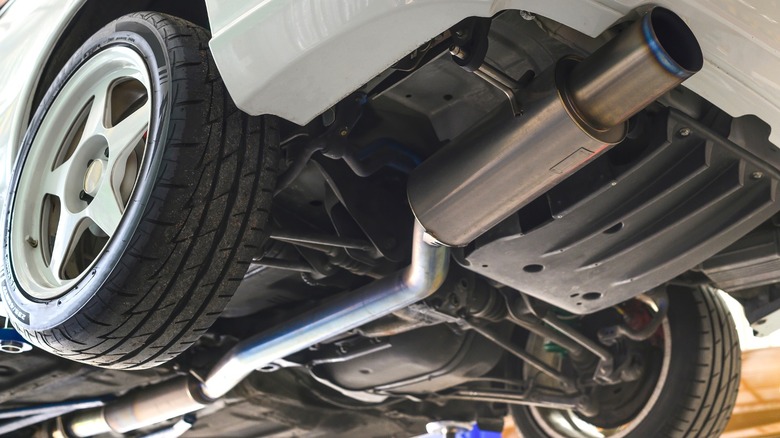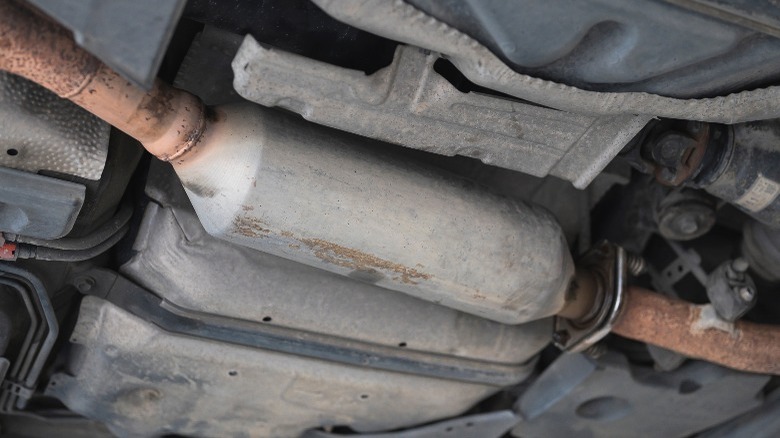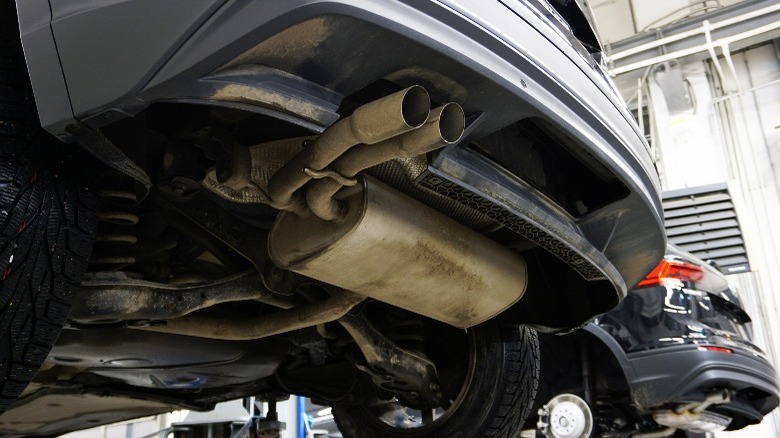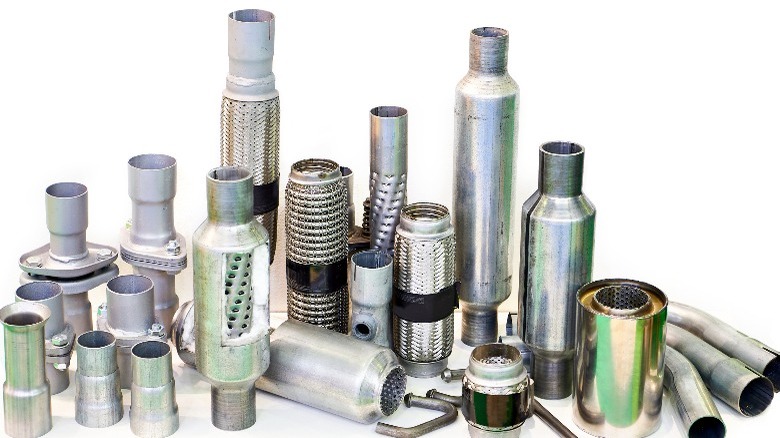Resonator Vs Muffler: What's The Difference?
Resonators and mufflers are both parts of a vehicle's exhaust system. But if you look at the two components side by side, you may struggle to see the difference between them. That's not to say that resonators and mufflers look identical. In fact, mufflers and resonators tend to have distinct appearances with some shared characteristics. However, to the untrained eye, both of these parts may look like metallic tubing. Not to mention, many car novices refer to the entire exhaust system simply as the muffler.
That's understandable — most of a car's exhaust system is made up of metal piping — like headers and exhaust manifolds — and to the uninitiated, the whole system may appear to be one part. We've already mentioned that resonators and mufflers are each individual parts of a vehicle's exhaust system. They're not the only components that comprise the system, either. That said, they are two very critical pieces of many exhaust systems, and learning about the differences can help you understand your car better.
So, what exactly is the difference between a resonator and a muffler? In basic terms, the muffler dampens the sounds your exhaust system makes. It's the part that prevents your car from sounding like a machine gun as you cruise through your neighborhood. Resonators, on the other hand, are responsible for improving how the exhaust sounds. They help remove high-pitched or otherwise unpleasant sounds from the exhaust and contribute to a more melodious, purring engine noise. That said, let's dive a little deeper and explore all of the differences between these two components and how they work on your vehicle.
What is a resonator?
Resonators are designed to improve the sound a car's exhaust system makes. Instead of dampening exhaust noise, resonators target and eliminate specific sound frequencies to produce a more pleasant exhaust sound. Typically, resonators are built to prevent high-pitched, raspy sounds and contribute to a deeper, more mellow sound. Most automotive resonators work using what's called a Helmholtz resonator, a device invented by 19th-century German physicist Hermann von Helmholtz. These devices can improve exhaust sound thanks to a phenomenon known as destructive interference. As sound waves enter the resonator's narrow tube, they bounce off the walls and hit each other. This causes some of the sound waves to cancel each other out, resulting in a more pleasant exhaust sound.
Typically, resonators are positioned between the catalytic converter and the muffler in a car's exhaust system. But that's not always the case. Some vehicles feature resonators after the muffler, while others have a single combined muffler-resonator unit. Other cars don't have a resonator at all. If you're curious whether your car has a resonator, you can check your vehicle repair manual or contact your local dealership.
What is a muffler?
Mufflers are designed to reduce exhaust system noise levels. While resonators improve the way your exhaust sounds, mufflers help prevent that sound from being too loud. These devices are built with special chambers and partitions — often made of various materials, like fiberglass and steel wool — to absorb sound waves and prevent excess noise. Mufflers tend to be larger than resonators, and most are shaped like big, boxy tubes with smaller pipes on each end. Exhaust gases enter the muffler at one end and exit the muffler at the other end. Depending on the design, the gases may navigate through a series of chambers and pipes or the muffler and out the other end.
Mufflers tend to be positioned at the rear end of a car. They're usually the final component that the exhaust gases pass through before entering the atmosphere. That said, some vehicles have mufflers in front of the resonator, while other cars have dual exhaust systems and feature two mufflers. If you're curious about the type, number, or position of the muffler(s) on your vehicle, you can find more information about your exhaust system in your owner's manual or repair guide. Alternatively, you can reach out to a representative at your local dealership.
Which do you need?
As mentioned earlier, most vehicles come stock with at least one resonator and muffler built into the exhaust system. If your car doesn't come with a resonator, you probably don't need to invest in one. Most casual drivers will never need to touch their exhaust systems outside routine maintenance and standard repairs.
That said, there are some instances in which drivers may want to purchase an aftermarket muffler, resonator, or both. If you're restoring a vintage vehicle, you may need to buy or fabricate a new exhaust system to complete the build. That may translate to purchasing an entire exhaust system or simply bolting on a new muffler or resonator. Alternatively, if you're working on a custom-project car, you may choose to purchase aftermarket exhaust components — like a resonator and muffler — to improve your vehicle's performance and sound. Exhaust system upgrades are one of the most basic and affordable performance-boosting car mods.
Whether you need a resonator, muffler, or both depends on the vehicle and your goals. For example, if you're concerned primarily with increasing horsepower outputs, you may be able to skip the resonator and purchase a high-performance exhaust system instead. On the other hand, if you want your custom build to purr like a kitten, you'll probably want to invest in a quality resonator. Whatever you ultimately choose to do, it's crucial that you research your build thoroughly. Understanding your car and its capabilities will help you decide what parts to buy and determine whether you need a resonator or muffler.



